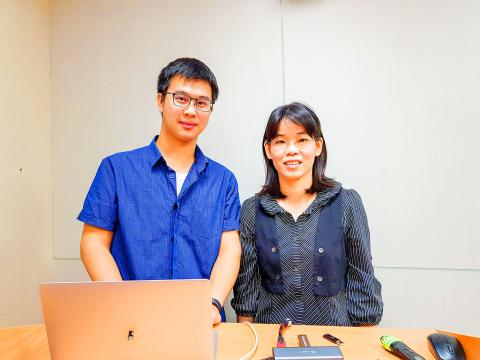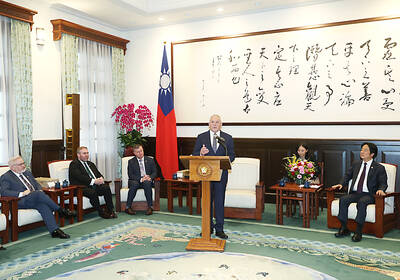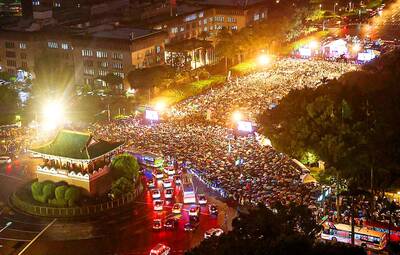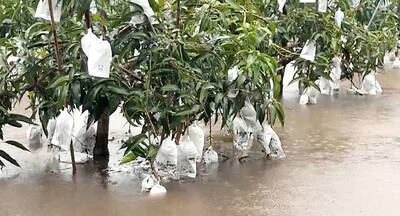Academia Sinica geoscience researchers yesterday unveiled a study that used GPS data to track the nation’s crustal changes following the 921 Earthquake in 1999, to shed more light on the creation of mountains and seismic cycles.
The magnitude 7.3 earthquake occurred on Sept. 21, 1999, in Nantou County’s Jiji Township (集集), leaving 2,456 people dead and destroying thousands of buildings.
Subterranean rocks at a depth of 20km had stabilized one year after the quake, but deeper layers might be still changing very slowly today, Academia Sinica Institute of Earth Sciences researcher Hsu Ya-ju (許雅儒) said.

Photo: Chien Hui-ju, Taipei Times
While GPS data has been used to study fault lines in previous studies, the team developed a new method of using such data to model geographical changes from the Earth’s surface to subterranean layers 50km in depth without having to make a lot of hypotheses, she said.
The study extends from a master’s thesis written by Tang Chi-hsien (唐啟賢) in 2016, when he was studying at National Central University, Hsu said.
Tang, 27, is serving alternative military service by doing research at the institute and plans to return to National Taiwan University to complete his doctoral degree.
Hsu and Tang worked with University of Southern California professor Sylvain Barbot and Nanyang Technological University professor James Moore to study GPS data about crustal changes collected over 14 years following the quake.
Taiwan has many mountains higher than 3,000m, but it is not yet clear how they arose from the Earth’s crust and the team’s study could offer some clues, Tang said.
Tang grew up in Hualien, where earthquakes are frequent, and that motivated him to research seismic activity, he said.
The team detailed their findings in a paper titled “Lower-crustal rheology and thermal gradient in the Taiwan orogenic belt illuminated by the 1999 Chi-Chi earthquake” which was published in the journal Science Advances.
The team’s findings are also useful for other nations, as rock strata in different nations share common features, institute director Chung Sun-lin (鍾孫霖) said.
To commemorate the 20th anniversary of the 921 Earthquake, the Taiwan Earthquake Research Center is to hold an international conference in September, Chung added.

‘NON-RED’: Taiwan and Ireland should work together to foster a values-driven, democratic economic system, leveraging their complementary industries, Lai said President William Lai (賴清德) yesterday expressed hopes for closer ties between Taiwan and Ireland, and that both countries could collaborate to create a values-driven, democracy-centered economic system. He made the remarks while meeting with an Irish cross-party parliamentary delegation visiting Taiwan. The delegation, led by John McGuinness, deputy speaker of the Irish house of representatives, known as the Dail, includes Irish lawmakers Malcolm Byrne, Barry Ward, Ken O’Flynn and Teresa Costello. McGuinness, who chairs the Ireland-Taiwan Parliamentary Friendship Association, is a friend of Taiwan, and under his leadership, the association’s influence has grown over the past few years, Lai said. Ireland is

A saleswoman, surnamed Chen (陳), earlier this month was handed an 18-month prison term for embezzling more than 2,000 pairs of shoes while working at a department store in Tainan. The Tainan District Court convicted Chen of embezzlement in a ruling on July 7, sentencing her to prison for illegally profiting NT$7.32 million (US$248,929) at the expense of her employer. Chen was also given the opportunity to reach a financial settlement, but she declined. Chen was responsible for the sales counter of Nike shoes at Tainan’s Shinkong Mitsukoshi Zhongshan branch, where she had been employed since October 2019. She had previously worked

FINAL COUNTDOWN: About 50,000 attended a pro-recall rally yesterday, while the KMT and the TPP plan to rally against the recall votes today Democracy activists, together with arts and education representatives, yesterday organized a motorcade, while thousands gathered on Ketagalan Boulevard in Taipei in the evening in support of tomorrow’s recall votes. Recall votes for 24 Chinese Nationalist Party (KMT) lawmakers and suspended Hsinchu City mayor Ann Kao (高虹安) are to be held tomorrow, while recall votes for seven other KMT lawmakers are scheduled for Aug. 23. The afternoon motorcade was led by the Spring Breeze Culture and Arts Foundation, the Tyzen Hsiao Foundation and the Friends of Lee Teng-hui Association, and was joined by delegates from the Taiwan Statebuilding Party and the Taiwan Solidarity

TRANSPORT DISRUPTION: More than 100 ferry services were suspended due to rough seas and strong winds, and eight domestic flights were canceled, the ministry said Tropical Storm Wipha intensified slightly yesterday as it passed closest to Taiwan, dumping more than 200mm of rain in Hualien and Taitung counties, the Central Weather Administration (CWA) said. As of 11am, Wipha was about 210km southwest of Cape Oluanpi (鵝鑾鼻) and was moving west-northwest at 27km per hour (kph). The storm carried maximum sustained winds of 101kph and gusts reaching 126kph, with a 150km radius of strong winds, CWA data showed. Wipha’s outer rainbands began sweeping across Taiwan early yesterday, delivering steady rainfall in the east and scattered showers in other regions, forecasters said. More heavy rain was expected, especially in the eastern